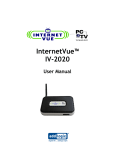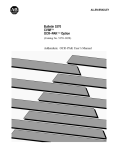Download Addlogix Network Testing Device CTK-LNTRK User's Manual
Transcript
User’s Guide CTK-LNTRK LAN Tracker Overview: Addlogix’s CTK-LNTRK Tracker is a 3-in-1 tester that includes the functions of 1) network tester, 2) tone generator, and 3) pin-by-pin cable tester. PH-120 LAN Tracker is a portable easy-to-operate tester that combines the functions of tone generator and network activity detector that can flash network hub’s, switches, and NIC’s port to indicate the network port. It also performs loo-back or remote validation of network, data, voice, and coaxial cables by displaying the test result on its LED display. The display shows pin-by-pin configuration that can move forward or backwards in both automatic and manual fashion. Other functions include validating the integrity of a cable’s shielding, and it can ‘trace’ a cable through its tone generator function and its ability to turn on network port’s activity on Hubs and NICs. Its line tester tests for line polarity and detects whether an AC or DC voltage is present on the line. The tester can also identify an inactive network’s speed (10/100/1000mbps). Features: • • • • • Provides pin-by-pin configuration of 1-8 pin cables Detects network’s activity and speed Detects inactive network device type and speed Traces cable / network port with its built-in tone generator or its ability to turn on the activity LEDs on network hubs, switches, and NICs Checks line polarity and detects if AC/DC voltage is present Operations: 1. About live / active networks: When testing an installed cable, please verify if a voltage is present on a network by using the built-in voltage detector. If voltage is detected, unplug the power adapter from the network equipment first. Never use the tester on live network and cables. To do so, plug one end of the cable to the remote unit’s jack. The result will be displayed on the “LINE TEST” LED on the unit. If the LED lights up, voltage is detected. Green indicates normal polarity; red indicates reverse polarity, and yellow indicates AC voltage. 2. Available Test Modes: • Automatic Mode – Set the tester to “Automatic” mode by holding down the “Step” button for one second. If the tester is in “Network Test” mode, press either the “Step” button or the “Backward” button to change the tester to “Automatic” mode. • Network Test Mode – Set the tester to “Network Test” mode by holding down the “Backward” button for 1 second • “Step Test / Manual” Mode – If the tester is in “Automatic” mode, press the “Step” or “Backward” button once to change the tester to “Step Test / Manual” mode. If the tester is in “Network Test” mode, press the “Step” or “Backward” button twice to change the tester to “Step Test / Manual” mode. 3. Test Mode LED: The tester’s test mode status LED indicates what mode it is in. • Automatic Mode – LED is blinking • Network Test Mode – LED is lit solid • Manual / Step Test Mode – LED is blank / unlit 4. Available Tests: Testing Cables Test a cable by connecting one end of the cable to the main tester and the other end to the tester’s remote unit. In “Automatic” test mode, the tester will automatically cycle through each pin, while displaying the test result on the LED. In “Manual / Step” test mode, the tester will test one pin at a time. Press the “Step” button to test the next pin. Loop Back Test A loop back (test without using the tester’s remote unit) can be performed by connecting one of the cable to the main tester’s “TX” socket and the other end of the cable to tester’s “RX” socket. Testing Installed Cable / Wiring Test an installed cable or wire by connecting one end of the cable or wire to the main tester’s TX port and the other end to the tester’s remote unit. In “Automatic” test mode, the tester will automatically cycle through each pin, while displaying the test result on the LED. In “Manual / Step” test mode, the tester will test one pin at a time. Press the “Step” button to test the next pin. Shielding Integrity Test Shielding validation will be done under both “Automatic” and “Manual / Step Test” modes. The shielding LED (“S” on the main unit, “Shield” on the remote unit) will come on indicating shielding integrity. Checking a Network Refer to the information above to make sure the network is not a live circuit. Connect one end of a cable (the other end connected to a wall jack or patch panel) to the main tester unit’s “TX / Net Test” jack. Set the tester to “Network Test Mode” (see instructions above). The tester will automatically check for network and display the result on the main tester’s LED display that’s labeled “Active Network”. • 10 Base-T Network: indicated by a solid lit LED • 10/100 or 10/100/1000Mbps Network: indicated by a blinking LED • No activity: indicated by a blank LED The activity LED of the corresponding port of the connected network switches, hubs, or NICs will be lit during this operation. This allows the user to trace the end of a wire throughout the network. (Note: A crossover cable must be used when testing a NIC.) Checking an Inactive Network When used on an inactive network, LAN Tracker will not be able to indicate the network speed via its LED display as explained above. However, LAN Tracker can find the network’s intended bandwidth by checking how the cables are wired. The following diagrams can be used as reference. 1 2 3 4 5 6 7 10/100 Mbps Ethernet (HUB/NIC with Auto MDI/MDI-X Function) 8 12345678 10/100/1000 Mbps Ethernet 1 2 3 4 5 6 78 10 Base-T Ethernet Using the Tone Generator Function Tone will always be sent through the cable that’s connected to the main unit’s TX port. To send the tone a specific pin / wire of the cable, set the tester to “Manual / Step Test” mode (see above) and use the “Step” button to the desired pin. The tone can be detected by Addlogix Tone Probe (CTK-PROBE) or other standard tone probe. Low Battery Red (●) indicates the tester’s battery is low. When the indicator shows red, it’s recommended that the batter be replaced immediately to prevent misreads. (Note: It’s recommended that the 9V alkaline batter be removed if the tester is not used for an extended period.) Specifications: Power Size Weight Main unit - 9V alkaline battery Battery life - 60 hours (typical) Main unit - 4.9” x 2.67” x 1.13” / 125mm x 68mm x 28mm Remote unit - 5.13” x 1.28” x 1.11” / 130.7mm x 32.5mm x 28mm 195g / 0.43lb with battery Shipping weight: 320g / 0.7lb Operating Temperature 0° - 45°C (32° - 113°F) Material ABS Tone Frequency 800 HZ Supported Cable Types UTP, STP, 10 Base-T, Token Ring, TP-PMD, 10 Base-T/BNC, and USOC 8, 4, 2 cables. Maximum Supported Cable 1,500 feet Length Power Consumption 10 – 40 mA /sec Output Voltage 5V Traffic Test Network Traffic Detection Support: Visit the Product Support section at www.addlogix.com if you have any trouble using these products.
















